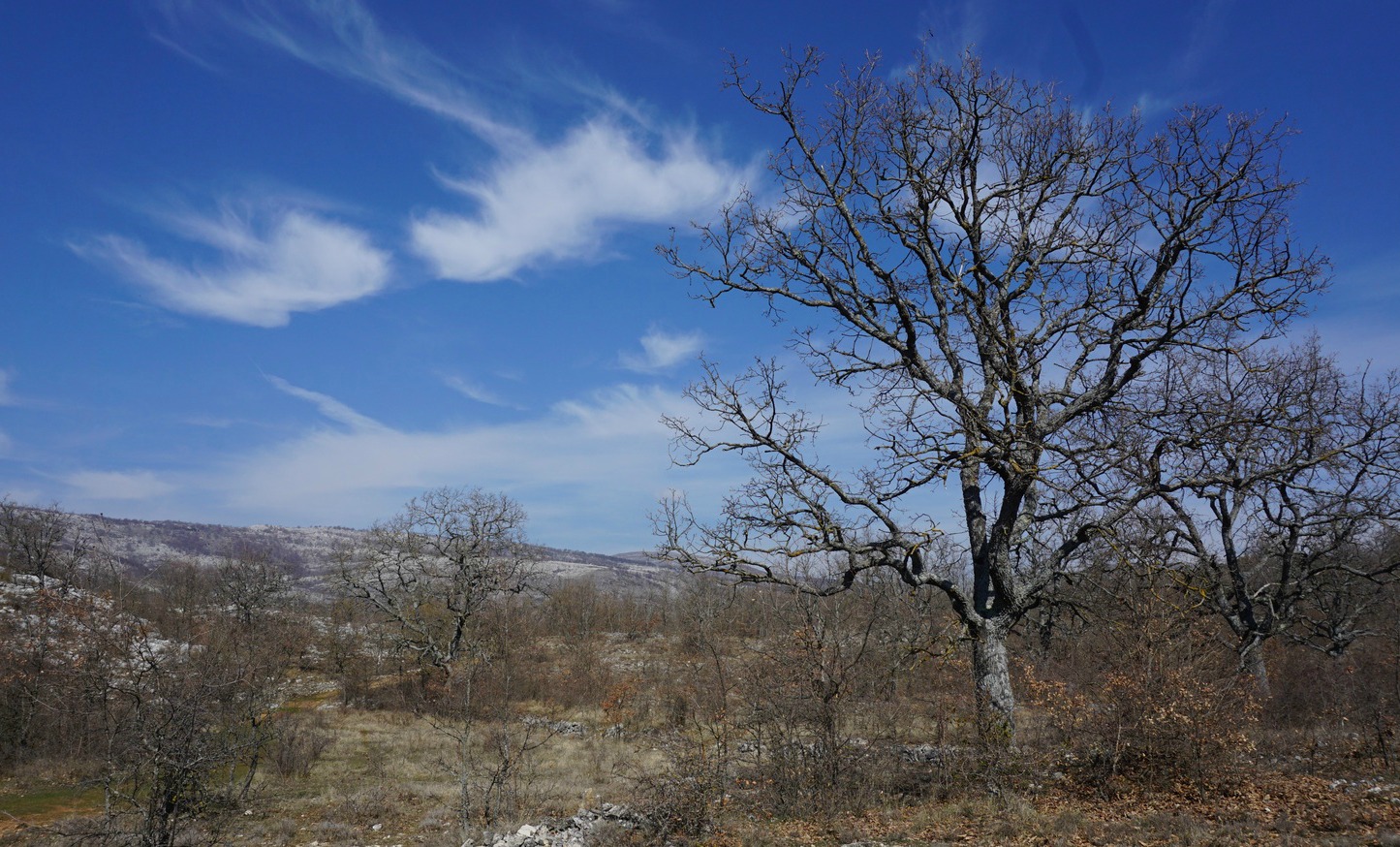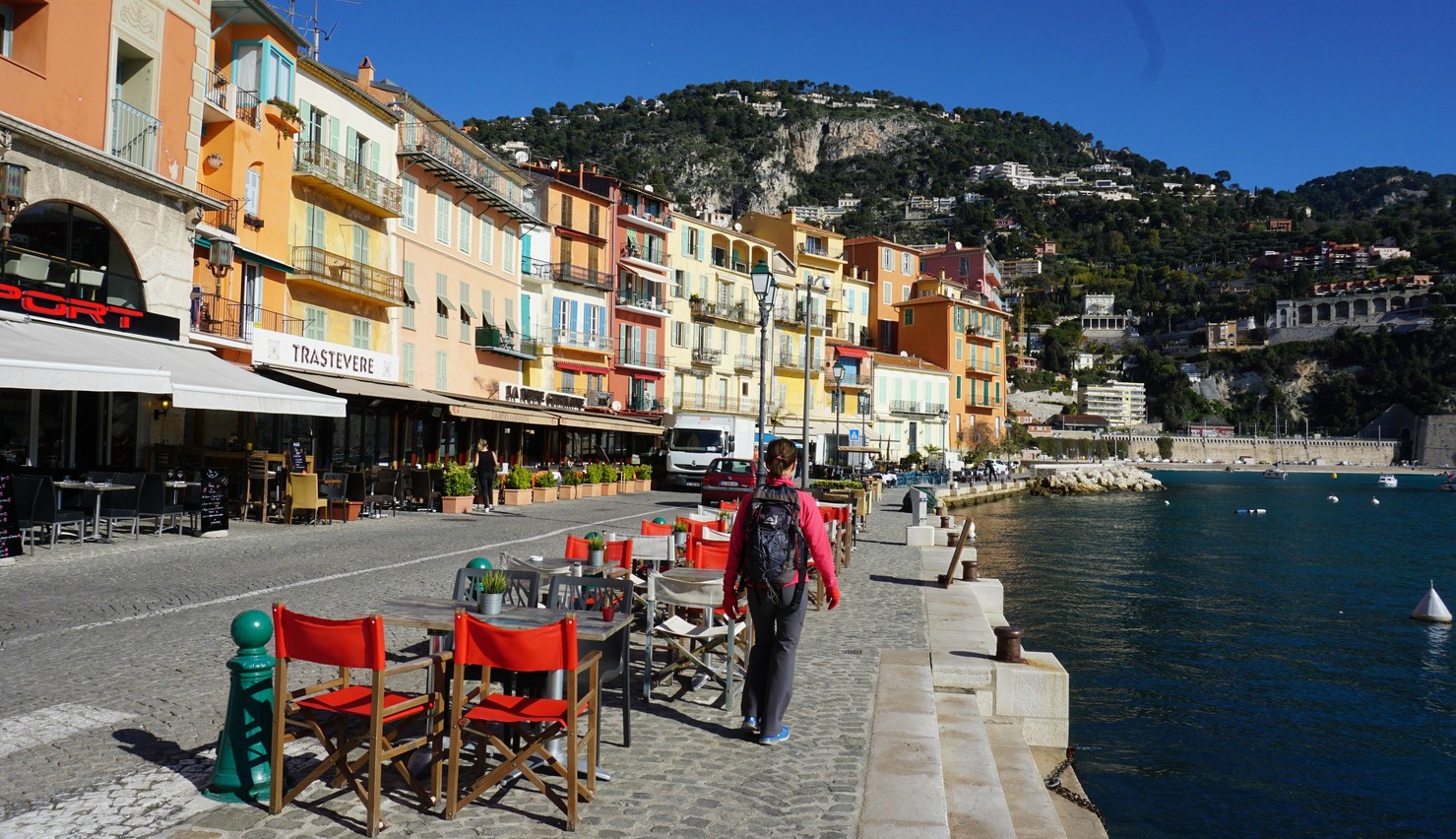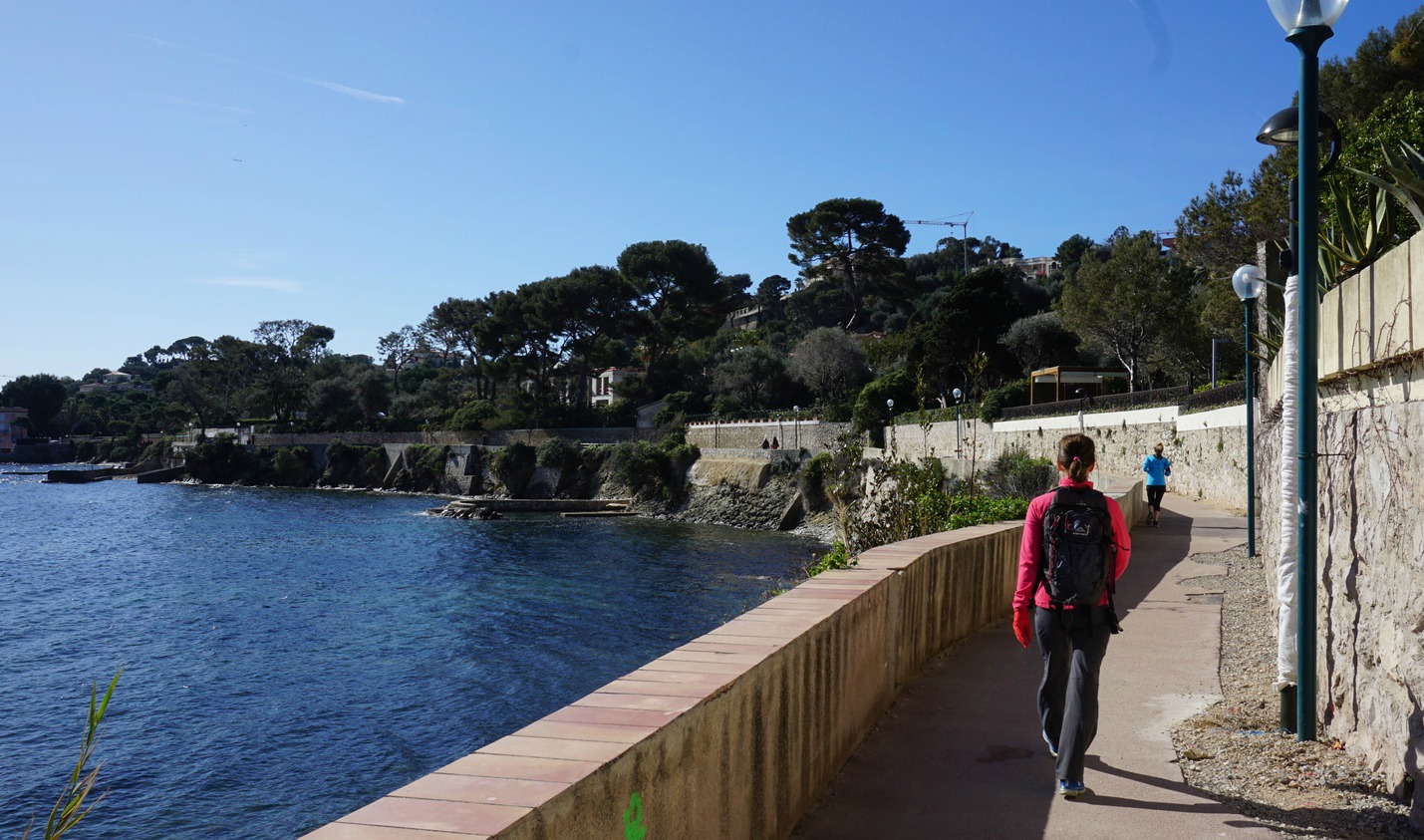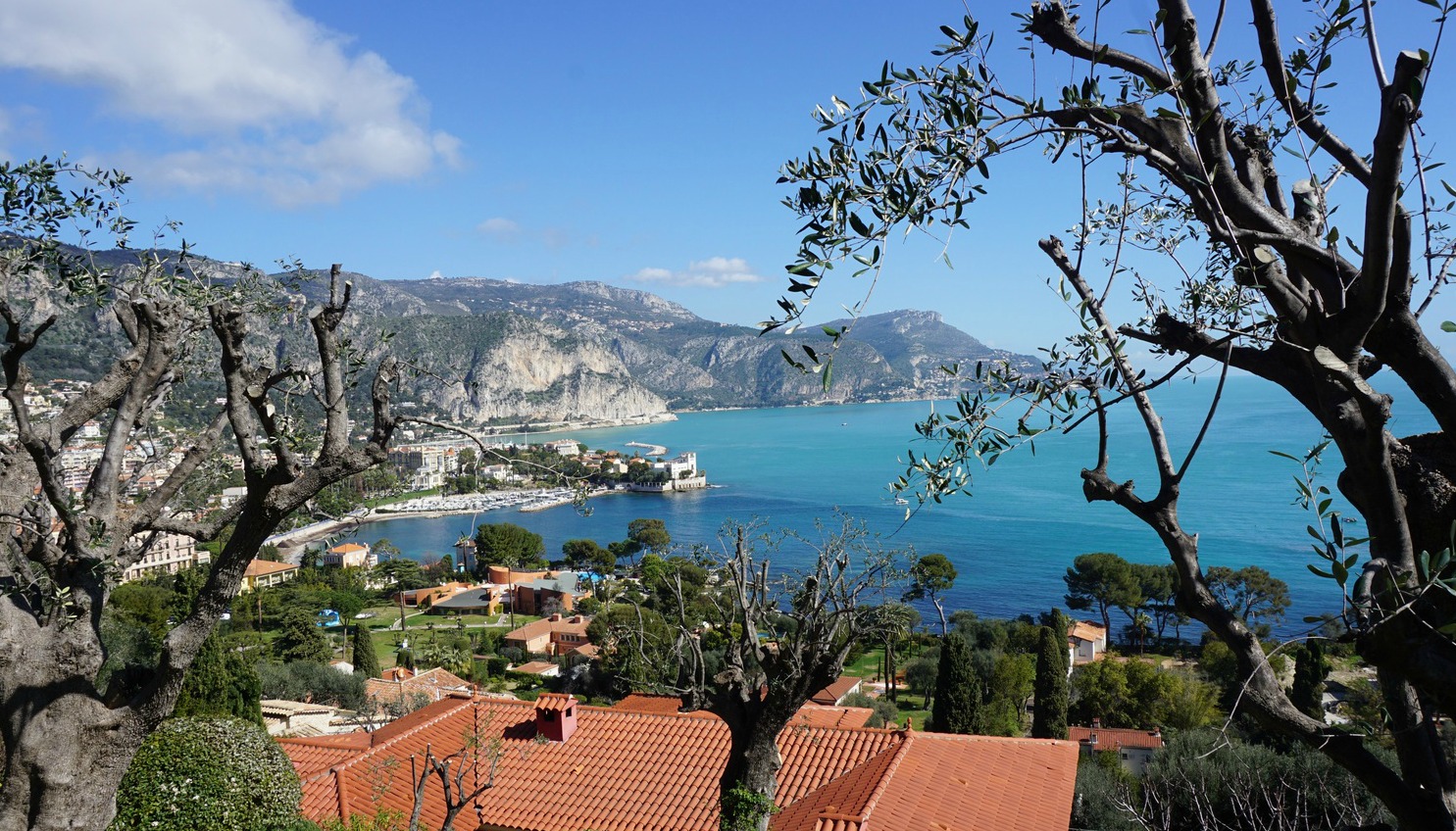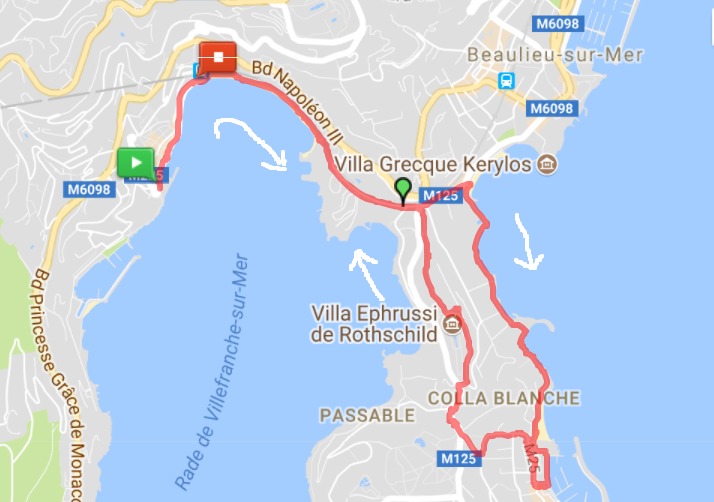

The French bakery industry is world famous. The global demand for its products is now increasing so much that last autumn the French TV news reported that the bakeries have problems obtaining enough butter! Luckily, I can still find pâte feuilletée, puff pastry, made with butter in our supermarket in Nice.
The following quiche recipe has a Greek twist because it is made with a generous amount of spinach and goat cheese or feta. I always choose pre-washed spinach in a bag for convenience. If you are good at baking, by all means make your own puff pastry from scratch.
4- 6 servings
A large bag, about 350g, pre-washed baby spinach leaves
3 eggs
200 g full-fat soft goat cheese or feta
2 tbsp. olive oil
2 shallots, chopped
2 cloves garlic, minced
Freshly ground black pepper
1 pâte feuilletée, ready- made puff pastry
Preheat the oven to 200-220°C (tart mode).
In a heavy casserole, cocotte, warm the olive oil over medium- low heat and fry the shallots and garlic for about 5- 10 minutes until softened. Add the spinach and continue cooking until the spinach is wilted. Set aside to cool and drain in a colander.
Roll out the puff pastry and line a 21- 22 cm quiche tin, moule à quiche. A non- stick loose based quiche tin guarantees easy removing.
In a large bowl, beat the eggs and black pepper. Cut the cheese into small pieces and add to the bowl. Add the drained spinach and mix.
Pour the mixture into the quiche tin and bake for about 30 minutes. Test the quiche with a wooden cocktail pick; it is done when the pick inserted near the centre comes out clean.
Let the quiche cool for a while. It is best served just warm, not hot, to bring out the flavours. A slice of quiche with some side salad makes a nice lunch. Any leftovers can be frozen.

Daube provençal is a classic South of France beef stew. The following version of veal, white wine, green olives, and fresh rosemary is a lighter spring stew. It is a typical French bistro dish. We recently had a similar stew in Paris this spring.
2 servings
2 tbsp. olive oil
About 400 g stewing veal, veau à mijoter
1 tbsp. flour
1 onion, coarsely chopped
1 clove garlic, minced
100 ml white wine
50 ml chicken stock
4 tomatoes, tomates en vigne
10 green olives
Freshly ground black pepper
2- 3 sprigs of fresh rosemary
Fresh parsley to decorate
Preheat the oven to 200° C.
If the stewing veal chunks are very large, cut them into smaller pieces about 3x3 cm.
Pour the olive oil in the bottom of a heavy casserole, such as Le Creuset. Place the meat in the casserole, add the flour, onion, garlic, black pepper, rosemary sprigs and stir.
Wash and coarsely chop the tomatoes. Add them to the casserole. Add the white wine, chicken stock and stir. The liquid does not need to wholly cover the meat and vegetables because spring tomatoes will yield some water. Transfer to the oven and roast for about 1 hour.
After 30 minutes, stir the stew.
When the stew is done, add the green olives. Divide on the plates, serve with new potatoes and decorate with parsley.
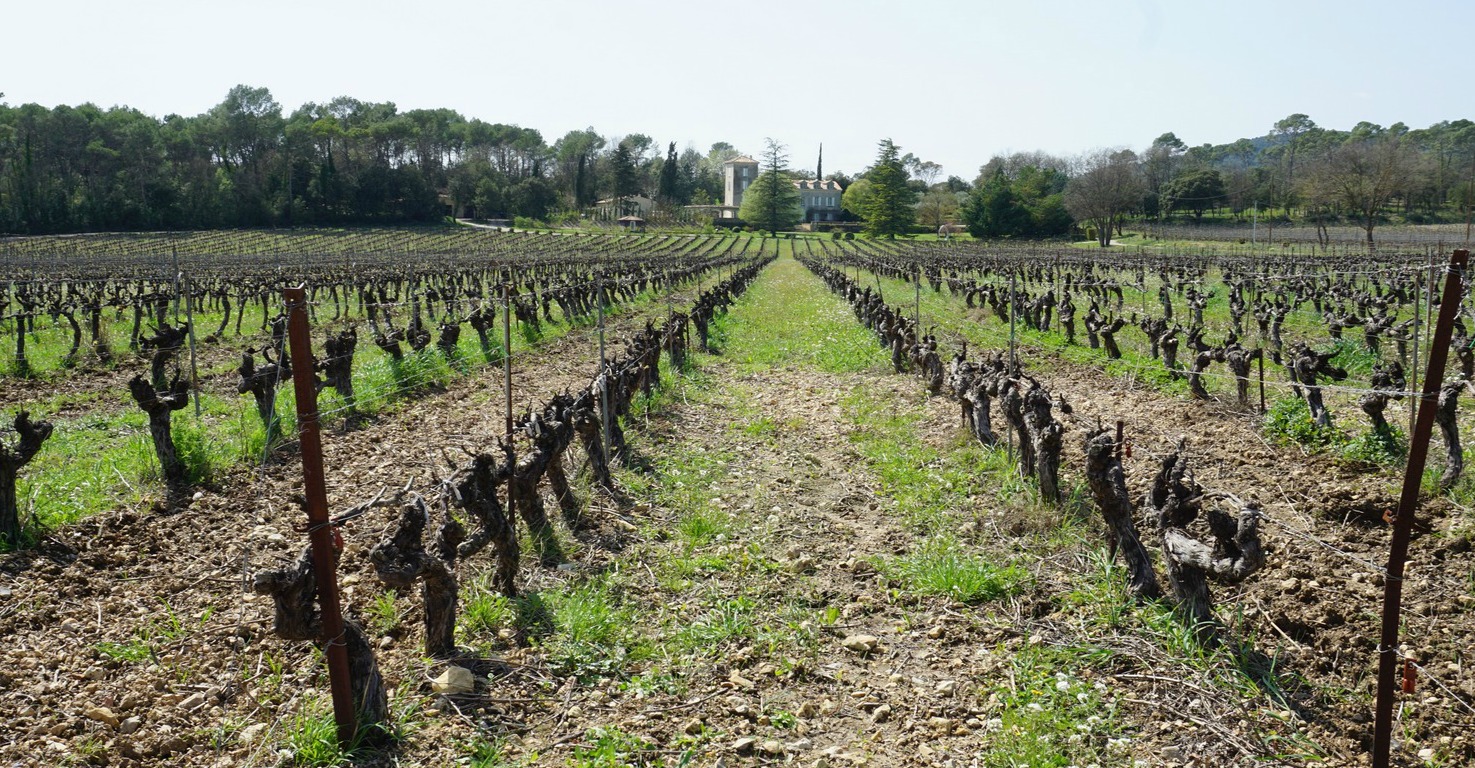
Our first stop was Château de Berne near Lorgues. We drove through Lorgues following signs to the Château. After a rather long drive along a narrow and winding road we suddenly saw the impressive domain in front of us. The domain has not only a vineyard, but also a 5-star spa hotel, a swimming pool, a bistro, a gourmet restaurant, and of course a wine shop. Various physical activities are offered. Their wine cellar produces 750000 bottles a year.
As many regions, including Paris, had school holidays, we had reserved a table in the bistro. The reservation was conveniently done online.
It was a warm and sunny spring day, and we were happy to sit outside. We all chose Formule de semaine which offered two choices of the first course and main course, then dessert or coffee. We opted for Caesar salad with giant shrimps followed by cod with red wine sauce and vegetables. Both dishes were exquisitely prepared and Berne’s rosé went very well with them.
After lunch we did some wine shopping. We have previously tasted their rosé which has always been fresh and fruity, but we were not so keen on their rectangular bottles. Luckily they had one rosé, Les Oliviers, in classic round bottles. It turned out to go very well with typical Provençal summer dishes back home, and at about 9€ per bottle was good value for money.
Our next stop was Château de Roubine between Lorgues and Draguignan. This 75-hectare vineyard has a long history; it has been known since 1307 when the Templar Knights sold it to the Order of St. John of Jerusalem. Later, various great Provençe families were the owners. From 1955, the Ministry of Agriculture awarded the title “Cru Classé” to the production of the domain. The vineyard is now owned by an ambitious couple making typically Provençal elegant wines. They export to 40 countries and have recently acquired the 50-hectare Ste Béatrice vineyard nearby. As a reminder of previously Monegasque ownership, many Ste Béatrice bottle labels continue to sport the coat of arms of Monaco.
It was easy to find their no-nonsense wine shop and vineyard by the D562 road. We were already familiar with their red Premium Cru Classé, about 15€ per bottle. As it is a bit hard to find in Nice, it was our natural choice.
We made a leisurely stroll in the vineyard following loosely the sentier vigneron, a footpath with information about their production, grape varieties etc. It was only us and the workmen in the vineyard bordered by pines, oaks, and the old castle surrounded by a garden.

Plan des Noves roughly 7 km north of Vence along the RD2 road is ancient farmland. Surrounded by hilltops, most of the plateau nowadays belongs to the Parc Naturel Départemental.
In spite of the modest elevation, this easy loop trail offers some great views towards the high mountains, the Baou St-Jeannet, and even a glimpse of the Mediterranean Sea.
The starting point is from the parking (780 m) of Plan des Noves by the RD2 road just before Col de Vence.
It was late March, but signs of spring were scarce. The weather during the last few weeks had been unusually cool and wet.
From the parking, we first followed the GR51 trail (white/red markings). Plan des Noves lies about 100 m below the starting point. The signposts marked the correct trail, showing the clockwise itinerary of Circuit du Plan des Noves. There were other paths and trails crisscrossing the plateau. At the first crossroads, we turned left (north), still following the GR51 a bit. After about 300 m, just before some ruins, we forked right leaving the GR trail and followed the trail with yellow markings. We crossed Plan des Noves heading southeast.
We then ascended a bit along a ridge with nice views to the east, notably to St-Jeannet and its Baou. We continued south, passing ruins of a stone hut, then to the west to a hill called Mangia Pan.
The trail now descended to the north, passing more ruins. We soon joined the GR51 again and ascended along it back to our starting point.
Duration: 2 h hiking time
Climb: 240 m
Distance: 7,5 km
Map: “Cannes-Grasse” Côte d’Azur 3643 ET
The image shows our GPS trail. The Randoxygène guide (in French) has a description of this hike, too.

I got the inspiration for this recipe from one of Martin Walker’s Bruno Chief of Police books. Bruno baked a whole salmon of three kilos wrapped in foil and flavoured with herb paste.
The following recipe is my twist of Bruno’s salmon. I have replaced the salmon with portion size trout and tarragon with dill. The recipe is glutenfree.
2 servings
2 portion size trout
½ organic lemon
2 tsp. Dijon mustard
For the herb paste:
Zest of ½ organic lemon
1 clove garlic, minced
2 tbsp. finely chopped parsley
2 tbsp. finely chopped dill
A pinch of salt
Freshly ground black pepper
4 tbsp. olive oil
Preheat the oven to 180° C.
Mix the herb paste. Then peel the lemon half and thinly slice it. Arrange the lemon slices inside the trout.
With a sharp knife, make deep slashes into the sides of the trout and stuff some herb paste into each slash. Stuff some herb paste inside the trout. Thinly coat the trout with Dijon mustard and spread the remaining herb paste on top.
Wrap the trout in foil and bake on a rack for 15- 20 minutes.
Serve the fish with wilted spinach or steamed asparagus and new potatoes or quinoa. The herb-
lemon flavoured olive oil when you open the foil will give a nice sauce.

Here in the South of France, endives are true winter vegetables. The following recipe, endives and mushrooms with chicken breast, is my twist of a recipe in Nice-Matin many years ago. Endives and mushrooms go just as well with pork or veal chops as with chicken breast.
2 servings
2 organic chicken breasts
2 tsp. pistou (purée of basil leaves, salt and olive oil)
2 nice endives
About 10 mushrooms, champignons de Paris, sliced
1 shallot, chopped
1 clove garlic, minced
3 tbsp. olive oil
4 tbsp. crème fraîche
150 ml white wine
butter
Black pepper
Parsley to decorate
Preheat the oven to 180°C.
Remove the outer layers from the endives and tail them. Microwave for 2- 3 minutes and dry with kitchen paper. Warm 1 tbsp. olive oil in a small frying pan over medium heat and fry the endives on both sides until golden. Transfer to a small buttered oven proof dish and cover with crème fraîche. Bake for 30 minutes in the oven; the crème fraîche reaches the texture of sauce béchamel. NB! Low fat crème fraîche does not work this way in the oven.
Meanwhile cook the mushrooms, chicken breasts and some brown rice.
In a frying pan warm 2 tbsp. olive oil over medium heat and start sautéing the sliced mushrooms. Sauté the chicken breasts over medium heat in the same pan that you used for the endives. First make a small pocket in the chicken breasts and fill with pistou. Then sauté on both sides until nicely coloured. Pour 50 ml white wine in the pan, cover and let simmer.
Add the chopped shallot and minced garlic to the pan with mushrooms. Continue sautéing for 10 minutes stirring occasionally. Then add the black pepper and remaining 100 ml white wine, cover and simmer at a very low heat.
Remove the endives from the oven to a warm plate. Pour the remaining crème fraîche from the oven proof dish into the pan with mushrooms and stir, you should have a creamy sauce in the pan.
Open the endives with a small knife and divide on the plates. Divide the chicken breasts and brown rice on the plates. Pour the mushroom- crème fraîche sauce over the endives and chicken breasts and decorate with parsley.
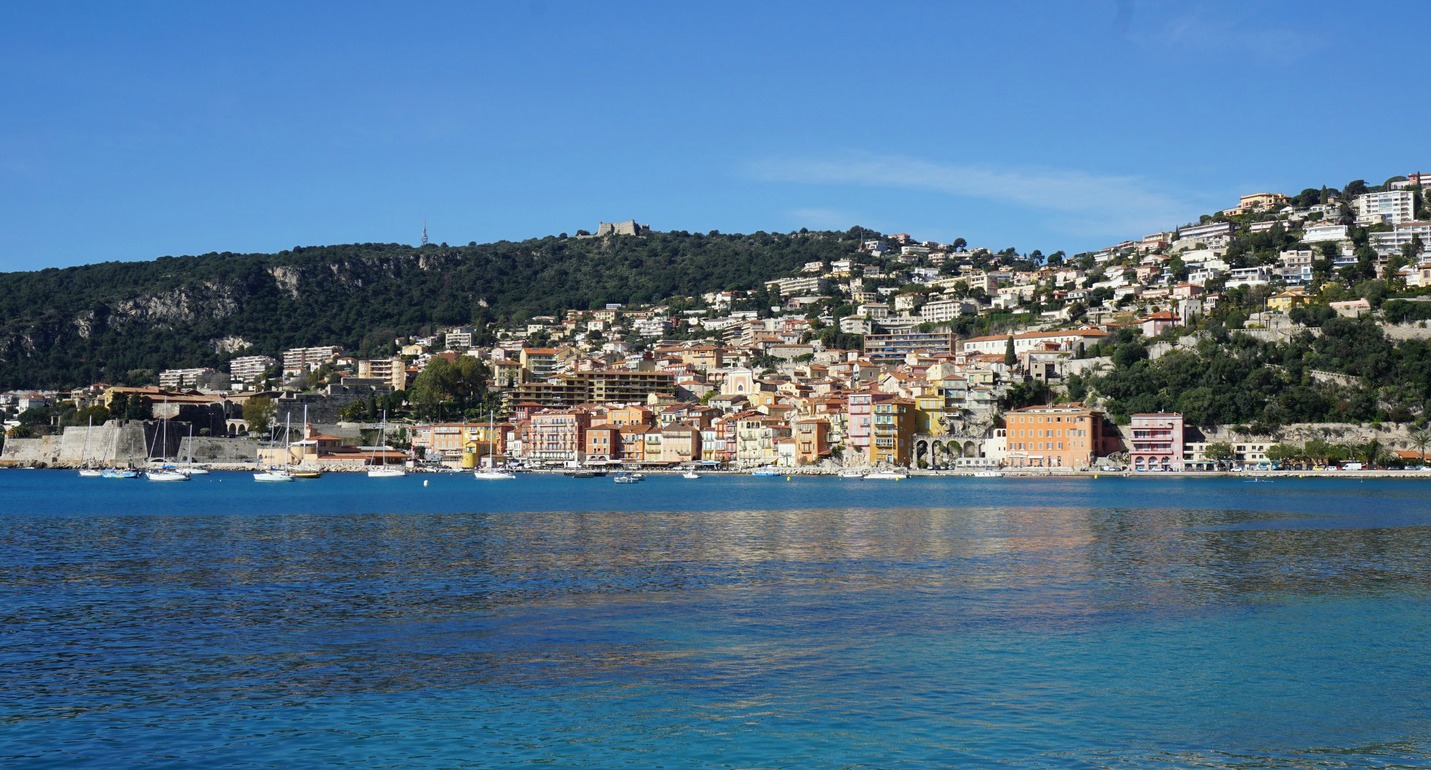
We started our walk from the harbour of Villefranche-sur-Mer, which is easily reached following the Basse Corniche (RM 6098). In the harbour there’s a spacious toll parking.
It is always a pleasure to walk along the Plage des Marinières, admiring the beauty of the location. On a sunny day, you never get tired of the views!
At the end of the beach, we took the stairs to elegant Av. Louise Bordes. After the crossroads we continued towards Beaulieu-sur-Mer and soon reached Plage des Fourmis. After briefly admiring Villa Kerylos on the other side of the bay, we took the Promenade Rouvier. This excellent and mostly paved path links Beaulieu-sur-Mer with Saint-Jean-Cap-Ferrat.
At the harbour of Saint-Jean, we took stairs to the terrace above. We saw that a lot of renovation work had recently been done there, with some new restaurants and cafes.
Our itinerary continued along Avenue Denis Séméria that ascended from the harbour, eventually passing the tourist office. At this point, it is best to stay on the left side where the pavement is continuous. After about 150 m, we crossed the rather busy main street and walked past the entrance of Villa Ephrussi de Rothschild.After 200-300 m, we forked left taking the stairs up to the top of the isthmus. The panoramic alley on the isthmus was called Chemin des Moulins. We followed it straight north and came to the main road and intersection (pont St-Jean) soon enough. From here, we walked back to our starting point.
Cruise ships frequently call at Villefranche-sur-Mer. This walk would be ideal for travellers who have not booked a shore excursion and wish to explore the area by themselves: A morning walk followed by lunch in the harbour or on board the ship!
Duration: 2 h
Distance: 8,1 km
Elevation gain: 85 m

It was a programme on the French morning TV, Télématin, which gave inspiration to this recipe. First the journalist told about the health benefits of red berries, such as raspberries, redcurrants, strawberries, blackberries and cranberries. These are packed with antioxidants which can protect from heart disease and other chronic diseases. It is good to know that frozen red berries retain most of their antioxidants.
Télématin then showed a French chef cooking cod with vegetables, sauce, and red berry compote. The following recipe is my twist of the cookery show. The dish is easy to cook, and the red berry compote gives an exotic twist to cod. The recipe is gluten free.
2 servings
2 nice pieces of cod fillet, about 150 – 200 g each
1 tbsp. olive oil
For the vegetables:
5 new potatoes
½ leek, finely sliced
1 clove garlic, minced
2 handfuls of baby spinach
2 tbsp. olive oil
For the sauce:
150 ml vegetable stock
2 tbsp. crème fraiche, 15% fat
2 tsp. Maizena
A few drops of lemon juice
Freshly ground black pepper
For the red berry compote:
1 tbsp. olive oil
A handful of different red berries (I used redcurrants and blackberries)
Preheat the oven to 200° C.
Place the cod fillets in an oven-proof dish and sprinkle with olive oil.
Warm the vegetable stock in a casserole until very hot. Dilute 2 tsp. Maizena in a small amount of cold water. Add enough of Maizena- water mixture into the vegetable stock whisking all the time until the sauce thickens somewhat. Let simmer on a very low heat about 15 minutes. Then add the crème fraiche and let simmer for about 5 minutes. When you are ready to serve the sauce, add the lemon juice and black pepper whisking briskly so that the sauce becomes a little foamy.
At the same time cook the vegetables. Warm 2 tbsp. olive oil in a large frying pan over medium heat. Start sautéing the sliced leek and minced garlic. Microwave the new potatoes 4 minutes until almost cooked, but still a bit al dente. Slice the potatoes and add to the pan. When you are almost ready to serve, add the baby spinach which only takes a couple of minutes to wilt.
Cook the cod fillets in the oven for 10- 12 minutes depending on the thickness. The fish needs to be opaque, but still flaky and not overcooked.
Meanwhile make the berry compote. Warm 1 tbsp. olive oil in a casserole over medium heat, add the berries, and mix now and again. The berries will “compote” by themselves and this doesn’t take long.
When you are ready to serve, divide the vegetables in the bottom of two bowls. Pour the sauce over the vegetables and place the cod fillet on top. Divide the berry compote around the fish and serve at once.

This recipe is inspired by a lady talking about her recipe, Poulet a ’l’ Estragon, on the local radio Bleu Azur while we were driving home from our supermarket in Nice. It sounded so good that I had to try it. The dish was a great success and I want to share it with you.
2 servings
4 chicken thighs with skin, pref. from poulet fermier, free range chickens
1 tbsp. olive oil
1 tbsp. butter
2 shallots, chopped
1 clove garlic, minced
3 carrots, sliced
100 ml white wine
100 ml chicken stock
Freshly ground black pepper
2 tbsp. crème fraîche, 15 % fat
Fresh tarragon
Preheat the oven to 180° C.
In a heavy casserole such as Le Creuset warm the olive oil and butter over medium heat. Fry the chicken pieces on both sides until golden. Remove from the casserole and set aside.
Microwave the sliced carrots for 5 minutes. Peel and chop the shallots, peel and mince the garlic. Sauté the vegetables in the casserole for a few minutes. Place the chicken pieces back in the casserole. Add the white wine, the stock, black pepper, and a few sprigs of tarragon, and bring to the boil. Save some tarragon leaves for decoration.
Transfer the casserole in the oven and bake for 30 minutes. Meanwhile cook some brown rice.
Remove the casserole from the oven and remove the tarragon sprigs. Mix in 2 tbsp. crème fraîche. Divide the chicken, carrots and the sauce on the plates. Serve with brown rice and decorate with fresh tarragon leaves.

The combination broccoli florets, mozzarella balls, pine nuts and whole wheat pasta works surprisingly well. Broccoli is a popular winter vegetable in Italy. It is a nutritional powerhouse, full of vitamins C, K and folate, minerals, fiber and antioxidants.
Any pasta shape works in this lactovegetarian recipe. It makes a simple, quick and healthy dinner.
2 servings
½ broccoli head
1 shallot
1 clove garlic
2 tbsp. pine nuts
2 tbsp. olive oil
1 package (150g) mozzarella balls
About 4 tbsp. grated parmesan
Freshly ground black pepper
Whole wheat pasta for two servings
Parsley to decorate
Wash half of the broccoli head. If the broccoli head is little, use the whole head. Cut it into florets and microwave 5 minutes until soft. Set aside.
Warm the olive oil in a large frying pan over medium- low heat. Peel and chop the shallot, add to the pan. Pell and mince the garlic clove, add to the pan. Sauté for about 10 minutes until soft.
Meanwhile cook the pasta until al dente, this normally takes about 9- 10 minutes.
Increase the heat over medium in the frying pan. Drain the pasta and add to the pan. Add the broccoli, drained mozzarella balls, black pepper and half of the parmesan. Mix and let cook for a couple of minutes until everything is warm.
Divide the pasta in bowls and sprinkle with the rest of the parmesan and chopped parsley. Top with pine nuts.






















